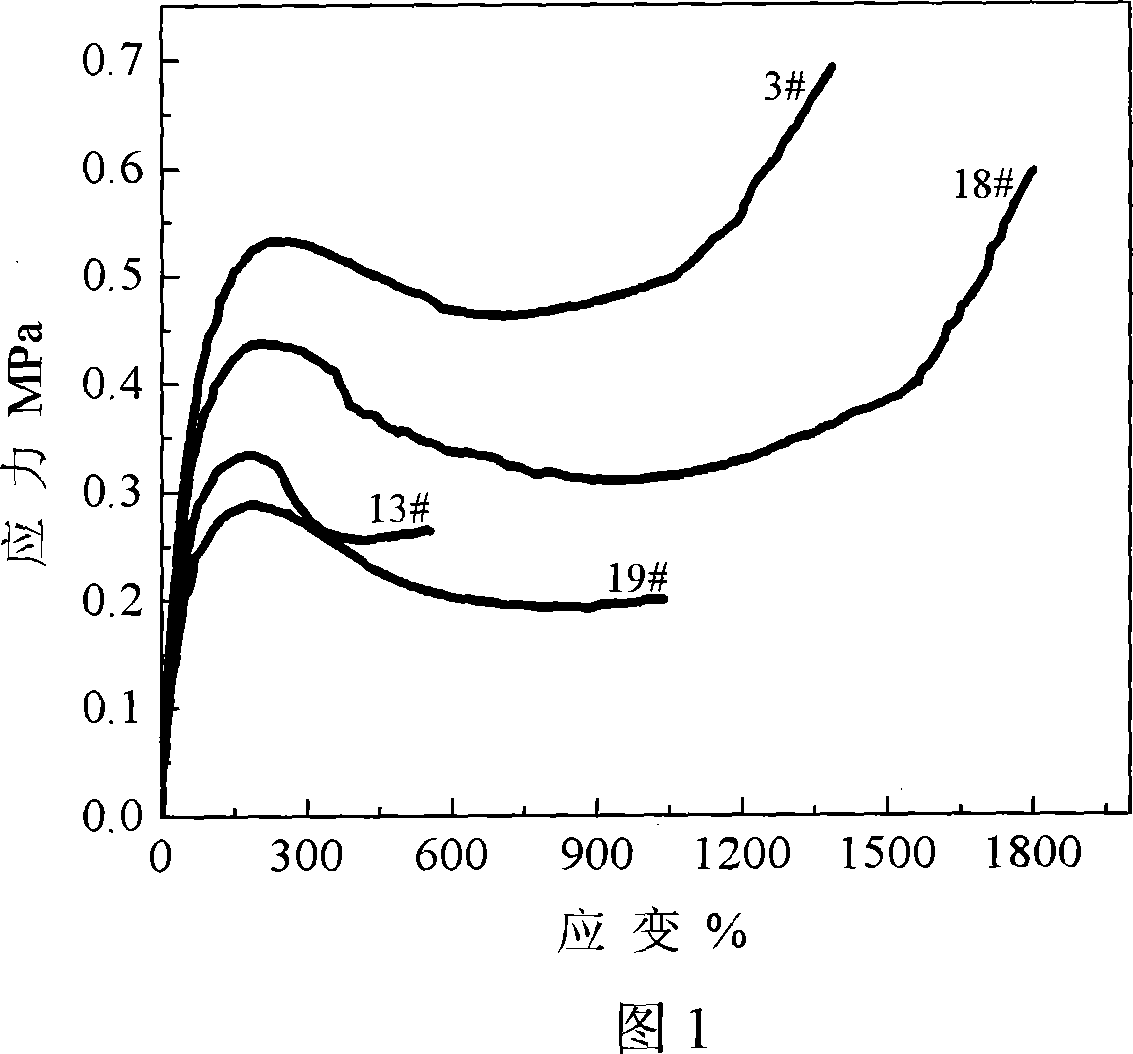Rare earth catalyst for preparing polyisoprene and preparation method and method for preparing polyisoprene
A rare earth catalyst and a technology for polyisoprene, which are applied to the rare earth catalyst for preparing polyisoprene and the preparation method and the fields of preparing polyisoprene, and can solve the problems of high corrosiveness of chlorine gas, environmental pollution and the like
- Summary
- Abstract
- Description
- Claims
- Application Information
AI Technical Summary
Problems solved by technology
Method used
Image
Examples
Embodiment 1
[0029] Under the protection of nitrogen, add 15 mL of 0.1M Nd(vers) to the dry catalyst reactor successively 3 Hexane solution, 15 mL of 1.0M isoprene in hexane, 15 mL of 2.0M Al(i-Bu) 3 Hexane solution, react at 50°C for 5 minutes to obtain a yellow-green solution; then add 15mL 0.2M Al(i-Bu) 2 Cl hexane solution, after reacting at 50°C for 30 minutes, a homogeneous rare earth catalyst for isoprene polymerization was obtained.
[0030] Under nitrogen protection, 2560 mL of hexane solvent and 440 mL of isoprene (300 g) monomer were added to a 5 L dry and oxygen-free autoclave, and the monomer concentration was 10 g / 100 mL at this time. Then add the above-mentioned prepared catalyzer, the molar number of catalyst Nd and the gram number ratio of adding monomer are 5.0 * 10 -6mol / g. After reacting at 40°C for 4 hours, the reaction was terminated with an ethanol solution containing 1.0% 2,6-di-tert-butyl-p-cresol, and then the polymer was precipitated in excess ethanol. °C and...
Embodiment 2
[0033] Under the protection of nitrogen, 24 mL of 0.1M Nd(vers) was sequentially added to the dry catalyst reactor 3 hexane solution, 48mL of 1.0M butadiene in hexane, 36mL of 2.0M Al(i-Bu) 3 hexane solution at 80°C for 1 minute to obtain a dark yellow-green solution; then add 12mL of 0.2M Al(i-Bu) 2 Cl in hexane solution reacted at 40°C for 120 minutes to obtain a homogeneous rare earth catalyst for isoprene polymerization.
[0034] Under nitrogen protection, 2560 mL of heptane solvent and 440 mL of isoprene (300 g) monomer were added to a 5 L dry and oxygen-free autoclave, and the monomer concentration was 10 g / 100 mL at this time. Then add the above-mentioned prepared catalyzer, the molar number of catalyst Nd and the gram number ratio of adding monomer are 8.0 * 10 -6 mol / g. After reacting at 40°C for 5 hours, terminate the polymerization with an ethanol solution containing 1.0% 2,6-di-tert-butyl-p-cresol, then precipitate the polymer in excess ethanol, wash and extrude...
Embodiment 3
[0037] Under the protection of nitrogen, 6 mL of 0.1M Nd(vers) was sequentially added to the dry catalyst reactor 3 hexane solution, 3mL of 1.0M piperylene in hexane, 6mL of 2.0M Al(i-Bu) 3 Add it into the reactor and react at 40°C for 5 minutes to obtain a yellow-green solution; then add 12mL of 0.2M Al(i-Bu) 2 Cl in hexane solution, react at 80°C for 5 minutes to obtain a homogeneous rare earth catalyst for isoprene polymerization.
[0038] Under nitrogen protection, 2118 mL of cyclohexane solvent and 882 mL of isoprene (600 g) monomer were added to a 5 L dry and oxygen-free autoclave, and the monomer concentration was 20 g / 100 mL at this time. Then add the above-mentioned prepared catalyzer, the molar number of catalyst Nd and the gram number ratio of adding monomer are 1.0 * 10 -6 mol / g. After reacting at 40°C for 4 hours, terminate the polymerization with an ethanol solution containing 1.0% 2,6-di-tert-butyl-p-cresol, then precipitate the polymer in excess ethanol, was...
PUM
| Property | Measurement | Unit |
|---|---|---|
| molecular weight distribution | aaaaa | aaaaa |
| molecular weight distribution | aaaaa | aaaaa |
| molecular weight distribution | aaaaa | aaaaa |
Abstract
Description
Claims
Application Information
 Login to View More
Login to View More - R&D
- Intellectual Property
- Life Sciences
- Materials
- Tech Scout
- Unparalleled Data Quality
- Higher Quality Content
- 60% Fewer Hallucinations
Browse by: Latest US Patents, China's latest patents, Technical Efficacy Thesaurus, Application Domain, Technology Topic, Popular Technical Reports.
© 2025 PatSnap. All rights reserved.Legal|Privacy policy|Modern Slavery Act Transparency Statement|Sitemap|About US| Contact US: help@patsnap.com

